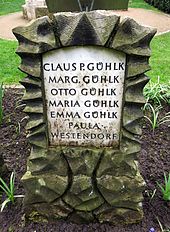Paula Westendorf
Paula Westendorf (born October 26, 1893 in Hamburg ; † October 3, 1980 ibid) was a politician of the SPD and a member of the Hamburg parliament .
Life
Paula Westendorf trained as a commercial secretary. After their marriage in 1917, she had 4 sons (1918, 1922, 1923 and 1925). After the divorce from her husband and the end of National Socialism , she returned to work in 1949. In the files of the citizenship she was listed as an "employee".
Her brother was the architect Otto Gühlk .
politics
Paula Westendorf got involved in politics and other social offices immediately after her liberation from the Nazi regime. From October 1946 she was a member of the first and second democratic citizenship after the Second World War . In the first electoral term she was one of 15 women in her parliamentary group (a total of 83 seats for the SPD).
In 1947 she was an assessor at the Administrative Court. In 1947 and 1953 she took over the post of deputy in the cultural authority and in 1948 in the building authority. In 1949 she also became a deputy member of the advisory committee for press law .
The fact that Paula Westendorf was also able to look beyond the boundaries of her party was shown by the application that she submitted as a supplement to and support for that of the KPD on the subject of § 218 . She was in favor of introducing the social indication as a reason for an abortion. She also called for public marriage and sexual counseling centers, which were also set up in August 1947 on the premises of the health department. It was the first of its kind in the western zones of occupation . In addition, she rejected the prosecution of the state as a "unilateral expression of power". She was of the opinion that "prohibitions do not deceive mankind because morality cannot be ordered" .
Paula Westendorf's tombstone is a lasting memory in the women's garden of the Ohlsdorf cemetery . The square was inaugurated on April 21, 2006 together with the square for the actress Philine Leudesdorff-Tormin (1892-1924). In 2007 a street in the Hamburg-Nord district was named in her honor. The streets in the "Kleine Horst residential area" are named after her and five other women who have made a name for themselves in Hamburg and are buried in the nearby Ohlsdorf cemetery.
Individual evidence
- ↑ Women's garden in the Ohlsdorf cemetery
- ↑ am-rand-der-zeit.de ( Memento of the original from July 31, 2007 in the Internet Archive ) Info: The archive link was inserted automatically and has not yet been checked. Please check the original and archive link according to the instructions and then remove this notice.
- ↑ GAL-Nord “short and green” No. 23 of December 23, 2006 ( Memento of the original of July 27, 2007 in the Internet Archive ) Info: The archive link was automatically inserted and not yet checked. Please check the original and archive link according to the instructions and then remove this notice.
literature
- Inge Grolle and Rita Bake : “I practiced juggling with three balls.” Women in the Hamburg citizenship from 1946 to 1993. Verlag Dölling & Galitz, Hamburg 1995, p. 407, ISBN 3-930802-01-5 (on behalf of State Center for Political Education Hamburg ).
| personal data | |
|---|---|
| SURNAME | Westendorf, Paula |
| BRIEF DESCRIPTION | German politician (SPD), MdHB |
| DATE OF BIRTH | October 26, 1893 |
| PLACE OF BIRTH | Hamburg , German Empire |
| DATE OF DEATH | 3rd October 1980 |
| Place of death | Hamburg |
